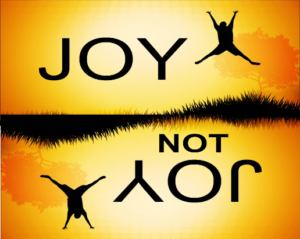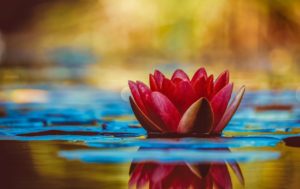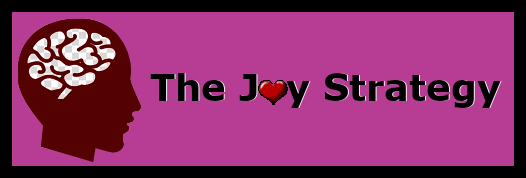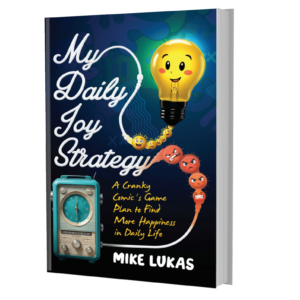Do the people around you seem happier?
More fulfilled?
Is something sucking the “happy” right out of your life?
To change your life, you need to change your priorities.
— Mark Twain
Welcome to The Joy Strategy, where our goal is to use the universal Law of Attraction to prioritize our daily Joy.
Emotions and feelings can get complicated.
GET CAUGHT UP!
If you haven’t already, please click to read the prior posts in this series:
“I’m pissed because that guy cut me off !!!”
“I’m jealous because she got the promotion instead of me.”
“I’m happy because I just got the promotion!”
Anger. Impatience. Jealousy. Insecurity. Frustration. Happy. Proud.

Each of those emotions has a separate narrative that triggers it, which can make it confusing and tough to pinpoint and narrow down.
What also complicates it for me is I try to figure out whether each emotion I feel is an appropriate response to the narrative that triggered it.
Then I compare my reactions and feelings with other people’s reactions and feelings, but that gets me nowhere since each of us is unique.
So the whole emotional thing gets complicated and confusing.
Whenever someone used to ask me, “Are you in a good mood, Mike?”
My answer was complicated.
That’s because emotions are complicated. My anxiety, my depression, my optimism, my humor, my cynicism, my fear and loathing all have to battle each other every step of the way, every hour of the day. It’s complicated to sort all that out and sum it up for a stranger.
“Define good,” I’d answer. “And mood.”
Joy or Not-Joy
Remember, the Dead People tell us that our day is spent in one of these two states or the other.
Joy or Not-Joy.
When I learned that, it totally simplified my life.
Especially with regards to how I was looking at my day.
All the emotions I feel are either Joy or Not-Joy.
Simple as that.

My complicated anxiety and fears and doubts and cynicism and jealousy and hate and anger?
All Not-Joy.
My complex happiness and hope and connectedness and humor and successes and love and occasional bliss?
All Joy.
Here’s what understanding that discovery has done for me.

Now when someone asks, “Are you in a good mood, Mike?”
My answer is simple.
I pause and figure out whether I’m in the middle of Joy or Not-Joy and answer with that.
The Dead People also taught me that Joy is the frequency of the source of all energy (again, what different humans call God or Yahweh or Abraham or Vishnu or Buddha).
So when you are feeling joyful, you are tapped into the positive frequency of the universe.
Which means you are connected and ready to joyfully create and receive. Yummy.
But when you are in the middle of Not-Joy, your connection to the universe is cut off.
That’s why it feels so hopeless and empty. Yucky.
Understanding that each moment of your life can be described with either Joy or Not-Joy gives you the ability to keep a better track of what frequency you are broadcasting more of and when.
Since, due to the law of attraction, the universe will automatically send you back more of that, Joy or Not-Joy, either way, the more Joy you signal, the more Joy you will eventually receive back.
It’s just how that universal law works.
Whether you know it (or like it) or not.

A helpful and eye-opening exercise you’ll do later in a future post is to assess the amount of Joy versus Not-Joy you experience during the course of a day or two.
Check in like it’s an Indy 500 pit stop.
During the day that is your race, you’ll take periodic pit stops to check your Joy levels.
You’ll use a Joy Thermometer to take your Joy Temperature.
“Is the activity I’m engaged in right now making me happy or frustrated?”
“Is there something unresolved in my life making me unhappy despite doing happy things?”
“If I’m honest, am I happy and do I know it? Can I, indeed, clap my hands right now?”
Following Vonnegut’s Advice
In one of author Kurt Vonnegut’s lectures, he talks about his Uncle Alex who would suddenly interrupt an agreeable situation to exclaim, “If this isn’t nice, I don’t know what is.”
Vonnegut says, ”Now I do the same, and so do my kids and grandkids. And I urge you to please notice when you are happy, and exclaim or murmur or think at some point, ‘if this isn’t nice, I don’t know what is.’”
That’s a Joy Moment Kurt’s talking about.
We’ll keep a tally of them, and at the end of the day, see if they outnumber your Not-Joys.
First time I did that, I couldn’t believe how many Not-Joy moments I collected throughout my day.
WAY more than I had thought.
It reminded me of the first time I ever did a monthly budget and realized how much money I was spending on beer and weed.
WAY more than I had thought.
This practice of checking your Joy Temperature begins to make you more aware of how often you pop out of Joy and stay in Not-Joy during the course of the day.
Gradually, one of the results of implementing your own Joy Strategy will be that switching from the Joy Station over to Not-Joy will begin to be completely noticeable to you. Because with a Joy Strategy in place, your Joy Temperature begins to appear on your radar more regularly.

The goal of the Joy Strategy is simple.
The goal of the Joy Strategy is to begin getting better at assessing how often during your day you switch between Joy and Not-Joy. How often your metaphysical radio is tuned to the Joy Station or not. So that you get a better idea of why the universe is sending you more of the same.
Then you can start to adjust your signal accordingly.
With a Joy Strategy in place, you can begin better controlling that frequency to your own advantage, using the Law of Attraction to your own positive benefit.
Next let’s talk in more detail about the Law of Attraction and Cause and Effect.

![You are currently viewing JOY STRATEGY [6]: How to Begin Prioritizing Joy](https://mike-lukas.com/wp-content/uploads/2021/06/Choose-Joy.jpg)


![Read more about the article JOY STRATEGY [1]: Use This Time-Honored Technique to Take Your Joy Temp](https://mike-lukas.com/wp-content/uploads/2021/05/Kid-Joy-1-1-200x300.jpg)
![Read more about the article JOY STRATEGY [5]: Three Critical Shout Outs](https://mike-lukas.com/wp-content/uploads/2021/06/shout-outs-300x169.jpg)
![Read more about the article JOY STRATEGY [8]: Reaction vs Response](https://mike-lukas.com/wp-content/uploads/2021/08/reaction-vs-response-1-300x233.jpg)
Thank you so much for sharing this wonderful post with us.
The information shared is of top quality which has to get appreciated at all levels. Well done…
Good web site you have here.. It’s hard to find good quality writing like yours these days. I honestly appreciate individuals like you! Take care!!
Nice of you to say, thanks!
Thanks for your exciting article. Other thing is that mesothelioma cancer is generally attributable to the breathing of dust from asbestos fiber, which is a dangerous material. Its commonly witnessed among individuals in the engineering industry who’ve long exposure to asbestos. It’s also caused by moving into asbestos covered buildings for a long time of time, Inherited genes plays an important role, and some individuals are more vulnerable on the risk than others.